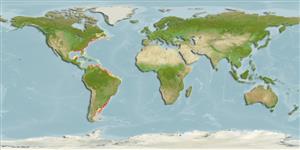Common names from other countries
Environment: milieu / climate zone / depth range / distribution range
экология
; солоноватоводный; пределы глубины 0 - 43 m (Ref. 108755). Temperate
Eastern Pacific and Western Atlantic: North America, Canada to Brazil.
Length at first maturity / Size / Вес / Возраст
Maturity: Lm ?, range 0 - 0.55 cm Max length : 2.0 cm CW самец/пол неопределен; (Ref. 79470); наибольший возраст (опубликованны данные): 2.00 годы (Ref. 109497)
Euryhaline. Prefers brackish waters, found in estuaries or quasi-freshwater lakes. Lives in muddy or sandy substrates, as well as on oyster reefs, vegetation, logs and manmade debris (Ref. 108786). Also on rubble (Ref. 97531). Omnivorous scavenger (Ref. 108786).
Life cycle: It undergoes four (4) zoeal stages and one (1) megalopa before turning into adult (Refs. 79470, 109437, 109442, 109461). Mating behavior: Precopulatory courtship ritual is common (through olfactory and tactile cues); usually indirect sperm transfer (Ref. 833). Spawning occurs from July to August in northern latitudes, April to September in mid latitudes, and April to November in southern latitudes (Ref. 109493). Females burrow in the sand to lay eggs prior to copulation, brooding takes 15-19 days (Ref. 109502).
Основная ссылка
ссылки | координатор | соавторы
Hill, M., R. Baker, G. Broad, P.J. Chandler, G.H. Coop, J. Ellis, D. Jones, C. Hoyland, I. Laing, M. Longshaw, N. Moore, D. Parrott, D. Pearman, C. Preston, R.M. Smith and R. Waters. 2005. (Ref. 1314)
Статус Красного Списка МСОП (Ref. 130435)
Статус СИТЕС (Ref. 108899)
Not Evaluated
Not Evaluated
Использование человеком
| FishSource |
инструменты
дополнительная информация
ресурсы в Интернет
Estimates based on models
Preferred temperature
(Ref.
115969): 7.2 - 22.9, mean 14.2 (based on 234 cells).
устойчивость к внешним воздействиям
высокий, минимальное время удвоения популяции до 15 месяцев (K=1.28; tmax=2).
Категория цены
Unknown.
